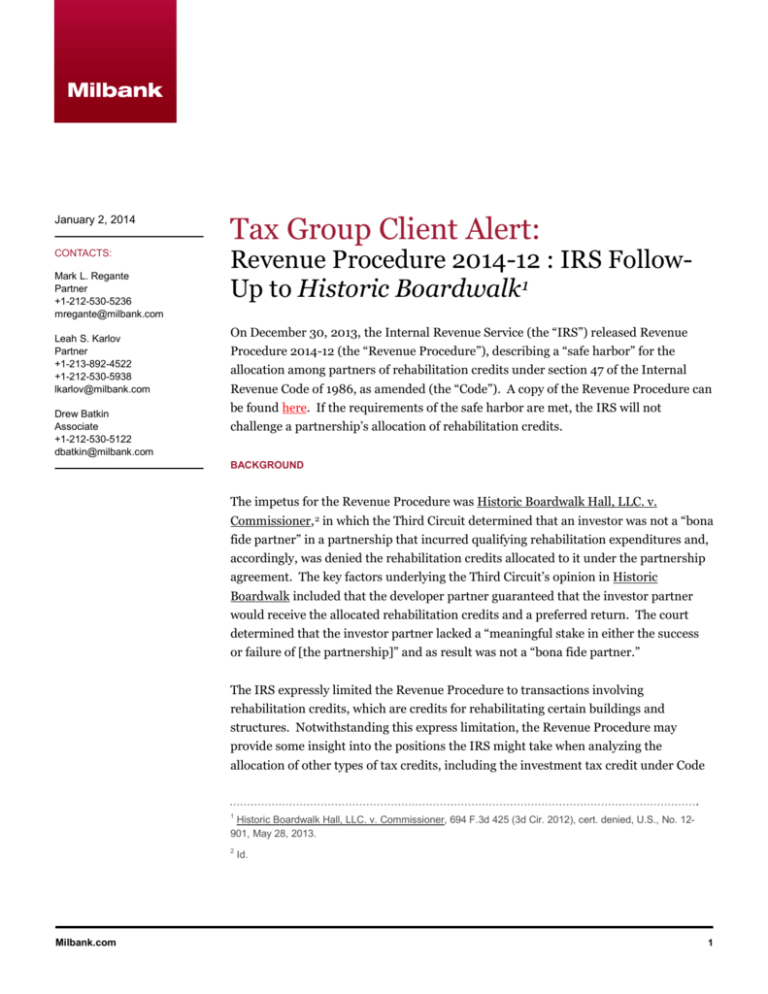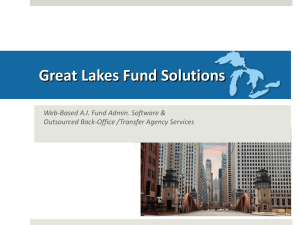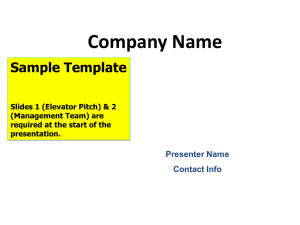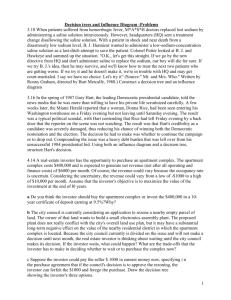
January 2, 2014
CONTACTS:
Mark L. Regante
Partner
+1-212-530-5236
mregante@milbank.com
Leah S. Karlov
Partner
+1-213-892-4522
+1-212-530-5938
lkarlov@milbank.com
Drew Batkin
Associate
+1-212-530-5122
dbatkin@milbank.com
Tax Group Client Alert:
Revenue Procedure 2014-12 : IRS FollowUp to Historic Boardwalk1
On December 30, 2013, the Internal Revenue Service (the “IRS”) released Revenue
Procedure 2014-12 (the “Revenue Procedure”), describing a “safe harbor” for the
allocation among partners of rehabilitation credits under section 47 of the Internal
Revenue Code of 1986, as amended (the “Code”). A copy of the Revenue Procedure can
be found here. If the requirements of the safe harbor are met, the IRS will not
challenge a partnership’s allocation of rehabilitation credits.
BACKGROUND
The impetus for the Revenue Procedure was Historic Boardwalk Hall, LLC. v.
Commissioner, 2 in which the Third Circuit determined that an investor was not a “bona
fide partner” in a partnership that incurred qualifying rehabilitation expenditures and,
accordingly, was denied the rehabilitation credits allocated to it under the partnership
agreement. The key factors underlying the Third Circuit’s opinion in Historic
Boardwalk included that the developer partner guaranteed that the investor partner
would receive the allocated rehabilitation credits and a preferred return. The court
determined that the investor partner lacked a “meaningful stake in either the success
or failure of [the partnership]” and as result was not a “bona fide partner.”
The IRS expressly limited the Revenue Procedure to transactions involving
rehabilitation credits, which are credits for rehabilitating certain buildings and
structures. Notwithstanding this express limitation, the Revenue Procedure may
provide some insight into the positions the IRS might take when analyzing the
allocation of other types of tax credits, including the investment tax credit under Code
1
Historic Boardwalk Hall, LLC. v. Commissioner, 694 F.3d 425 (3d Cir. 2012), cert. denied, U.S., No. 12901, May 28, 2013.
2
Milbank.com
Id.
1
section 48 for certain renewable energy property, Code section 48A for qualifying
advanced coal projects, and Code section 48B for qualifying gasification projects, as
well as the production tax credit under Code section 45. This, however, may be wishful
thinking as the rationale for some of the requirements set forth in the Revenue
Procedure is unclear. Further, although the Revenue Procedure seems to borrow from
some of the requirements and the analysis in a previously published Revenue
Procedure that sets forth the widely-followed safe harbor for “flip partnership”
investments in wind energy facilities (“Revenue Procedure 2007-65”), 3 at least with
respect to one material feature of these transactions, the Revenue Procedure states a
position that is contrary to and in direct conflict with the position set forth in Revenue
Procedure 2007-65. 4 Consequently, the value of the Revenue Procedure in connection
with analyzing partnership investments in other asset classes is unclear.
THE SAFE HARBOR
As an initial matter, in order to satisfy the safe harbor criteria, allocations under the
partnership agreement must satisfy the requirements of Code section 704(b) and the
Treasury Regulations thereunder, and the rehabilitation credit must be allocated in
accordance with Treasury Regulations section 1.704-1(b)(4)(ii). Generally speaking,
this means that the rehabilitation credit must be allocated to the partners in the same
ratio that the partners share the general profits of the partnership, or more specifically,
the taxable income of the partnership described in Code section 702(a)(8). The other
requirements of the safe harbor are described below.
For purposes of this description, the “Partnership” is the entity claiming the credits.
References to the “Developer Partnership” and to the “Master Tenant Partnership” are
relevant in the case of an inverted lease (or “pass-through lease”) transaction in which
the Developer Partnership owns and is rehabilitating the building and will claim
applicable depreciation and amortization deductions consistent with ownership and
the Master Tenant Partnership is leasing the building and will claim the applicable tax
credit pursuant to an election provided for under the Code.
The Revenue Procedure addresses Partnerships comprised of one or more “Investors”
and one or more “Principals.” A Principal is a partner authorized to act as a manager
for the Partnership and an Investor is a partner, other than a Principal, whose
investment satisfies the requirements of the Revenue Procedure. An Investor may be
an initial partner or may be a person who later purchases a Partnership interest.
MILBANK CLIENT ALERT: Tax Group
3
2006-42 I.R.B. 686.
4
See the discussion of ”purchase and sale rights” below.
January 2, 2014
2
References in the Revenue Procedure to Principal, Investor or Partnership include
“related persons” within the meaning of Code section 267(b) or Code section 707(b)(1).
DOUBLE DIPPING
An inverted lease transaction will be outside the safe harbor if the Investor holds an
interest in both the Master Tenant Partnership and the Developer Partnership, unless
the interest in the Developer Partnership is held indirectly by reason of the Master
Tenant Partnership holding an interest in the Developer Partnership. The prohibition
does not apply to a separately negotiated, distinct economic arrangement (e.g., a
separate arm’s length investment in the Developer Partnership to share in allocations
of federal new markets tax credits or low income housing credits). The scope of these
exceptions is unclear. For example, it is unclear whether the exception is violated by a
separate arm’s length investment in a Developer Partnership that allows the Investor to
share in other tax attributes (e.g., net losses attributable to accelerated depreciation).
It is also unclear why an indirect participation in the tax attributes resulting from the
Master Tenant Partnership holding an interest in the Developer Partnership does not
present the same opportunities for whatever abuse the prohibition is intended to
preclude.
MINIMUM PARTNERSHIP INTERESTS
As in the case of Revenue Procedure 2007-65, the Principal must have a minimum one
percent interest in each material item of Partnership income, gain, loss, deduction, and
credit at all times during the existence of the Partnership. Similarly, the Investor must
have, at all times during the period it owns an interest in the Partnership, a minimum
interest in each material item of Partnership income, gain, loss, deduction and credit
equal to at least five percent of the Investor’s percentage interest in each such item for
the taxable year for which the Investor's percentage share of that item is the largest (as
adjusted for sales, redemptions or dilution of the Investor’s interest).
BONA FIDE EQUITY INVESTMENT
The Revenue Procedure contains the following prescription:
The Investor’s Partnership interest must constitute a bona fide equity investment with a reasonably anticipated value commensurate with the Investor’s
overall percentage interest in the Partnership, separate from any federal,
MILBANK CLIENT ALERT: Tax Group
January 2, 2014
3
state, and local tax deductions, allowances, credits, and other tax attributes
to be allocated by the Partnership to the Investor. 5
Once again, the intent of this requirement is unclear. Although it could be read as
saying that the amount of the Investor’s investment or the purchase price paid for its
partnership interest must be determined without regard to tax attributes, that would
appear to go too far. The Revenue Procedure goes on to say:
An Investor’s Partnership interest is a bona fide equity investment only if that
reasonably anticipated value is contingent upon the Partnership’s net income,
gain, and loss, and is not substantially fixed in amount. Likewise, the Investor must not be substantially protected from losses from the Partnership’s activities. The Investor must participate in the profits from the Partnership’s
activities in a manner that is not limited to a preferred return that is in the
nature of a payment for capital. 6
Assuming these requirements are satisfied, we presume the general requirement first
quoted above in this section will be treated as satisfied. Note that the payment of
preferred returns, fees, and tax distributions are permitted, but such amounts will not
be determinative of whether an Investor has a bona fide equity investment.
NO OFF-MARKET OTHER ARRANGEMENTS
Compliance with the safe harbor requires that the value of the Investor’s Partnership
interest not be reduced through arrangements (e.g., fees or lease terms) that are
unreasonable as compared to similar arrangements in real estate development projects
that do not qualify for rehabilitation credits, and also may not be reduced by
disproportionate rights to distributions or by issuances of interests in the Partnership
(or rights to acquire interests in the Partnership) for less than fair market value
consideration. Section 4.06(2)(c) of the Revenue Procedure contains certain
limitations on subleasing that are presumably related to the concept, discussed below,
that the Investor must bear risk of loss and possibility of gain beyond a fixed return. In
particular, in the case of an inverted lease, a sublease to any person will be deemed
unreasonable if the duration of the sublease is as long or longer than the duration of
the head lease.
MILBANK CLIENT ALERT: Tax Group
5
Revenue Procedure § 4.02(2)(b).
6
Id.
January 2, 2014
4
INVESTOR’S MINIMUM UNCONDITIONAL CONTRIBUTION
Before the date that the rehabilitated building is placed in service, the Investor must
make an unconditional contribution to the Partnership in an amount equal to at least
20% of the Investor’s total expected capital contributions (the “Investor Minimum
Contribution”). The Investor must maintain the Investor Minimum Contribution
throughout the duration of its investment in the Partnership and, except for the
permissible guarantees described below, the Investor Minimum Contribution must not
be protected against loss through any arrangement, directly or indirectly, by any
person involved with the rehabilitation. Contributions of promissory notes or other
obligations for which the Investor is the maker are not included in determining
whether the Investor satisfies the Investor Minimum Contribution.
CONTINGENT CONSIDERATION
At least 75% of the Investor’s total expected capital contributions must be fixed in
amount before the date the building is placed in service. The Investor also must
reasonably expect to meet its funding obligations as they arise.
GUARANTEES AND LOANS
The Revenue Procedure provides that no person involved in any part of the
rehabilitation transaction may offer a guarantee that is not an unfunded permissible
guarantee. A guarantee is unfunded if (i) no money or property (other than certain
limited operating reserves) is set aside to fund any portion of the guarantee and (ii)
there is no minimum net worth requirement imposed in connection with the
guarantee. Permissible unfunded guarantees include: (i) completion guarantees, (ii)
operating deficit guarantees, (iii) environmental indemnities and (iv) financial
covenants. Specifically prohibited by the Revenue Procedure are guarantees (or
insurance) to insure the Investor’s ability to claim the rehabilitation credits, the cash
equivalent thereof, or the repayment of any portion of the Investor’s contribution due
to inability to claim the rehabilitation credits. Also prohibited are indemnities that
cover the Investor’s costs if the IRS challenges the Investor’s claim of the rehabilitation
credits. Note that the guarantee (and insurance) prohibitions do not prevent the
Investor from procuring insurance from persons not involved with the rehabilitation
transaction or the Partnership. In addition to the foregoing, the Revenue Procedure
requires that neither the Partnership nor the Principal lend funds to the Investor or
guarantee any indebtedness incurred to acquire any part of the Investor’s interest in
the Partnership.
MILBANK CLIENT ALERT: Tax Group
January 2, 2014
5
PURCHASE AND SALE RIGHTS
Under the Revenue Procedure, neither the Principal nor the Partnership may have a
call option or other contractual right or agreement to purchase or redeem the
Investor’s interest at a future date (other than a contractual right or agreement for a
present sale). Further, the Investor may not have a contractual right or other
agreement to require any person involved in any part of the rehabilitation transaction
to purchase or liquidate the Investor’s interest in the Partnership at a future date at a
price that is more than its fair market value determined at the time of exercise of the
contractual right to sell. Implicit in this limitation is that a “put” at a price less than the
then-determined fair market value is permissible. Note that the IRS took a contrary
and conflicting position in Revenue Procedure 2007-65.
In addition to the foregoing, to meet the safe harbor, an Investor may not acquire its
interest in the Partnership with the intent of abandoning the interest after the
Partnership completes the qualified rehabilitation. An intent to abandon is rebuttably
presumed if the Investor abandons its interest at any time.
CONCLUSION
The Revenue Procedure should alleviate some of the uncertainty caused by Historic
Boardwalk in the context of partnerships claiming rehabilitation credits. However, the
extent to which the IRS will apply the same principles to partnerships investing in
other asset classes is unclear.
MILBANK CLIENT ALERT: Tax Group
January 2, 2014
6
TAX GROUP
Please feel free to discuss any
aspects of this Client Alert with
your regular Milbank contacts or
any of the members of our Tax
Group.
If you would like copies of our
other Client Alerts, please visit
our website at www.milbank.com
and choose “Client Alerts” under
“News.”
This Client Alert is a source of
general information for clients
and friends of Milbank, Tweed,
Hadley & McCloy LLP. Its content
should not be construed as legal
advice, and readers should not
act upon the information in this
Client Alert without consulting
counsel.
NEW YORK
One Chase Manhattan Plaza, New York, NY 10005
Russell Kestenbaum
rkestenbaum@milbank.com
+1-212-530-5790
Andrew Walker
awalker@milbank.com
+1-212-530-5624
Joel Krasnow
jkrasnow@milbank.com
+1-212-530-5681
Dale Ponikvar
dponikvar@milbank.com
+1-212-530-5296
Mark Regante
mregante@milbank.com
+1-212-530-5236
LOS ANGELES
601 South Figueroa Street, 30th Floor, Los Angeles, CA 90017
Leah Karlov
lkarlov@milbank.com
+1-213-892-4522
+1-212-530-5938
©2014 Milbank, Tweed, Hadley &
McCloy LLP.
All rights reserved.
Attorney Advertising.
Prior results do not guarantee a
similar outcome.
Washington DC
1850 K Street, NW, Suite 1100, Washington, DC 20006
Glenn Gerstell
gerstell@milbank.com
+1-202-835-7585
MUNICH
Maximilianstrasse 15, (Maximilianhoefe), Munich 80539, Germany
Dr. Rolf Füger
rfueger@milbank.com
+49-89-25559-3616
Dr. Thomas Kleinheisterkamp
tkleinheisterkamp@milbank.com
+49-89-25559-3676
Dr. Norbert Rieger, LL.M.
nrieger@milbank.com
+49-89-25559-3626
London
10 Gresham Street, London EC2V 7JD, England
Russell Jacobs
MILBANK CLIENT ALERT: Tax Group
January 2, 2014
rljacobs@milbank.com
+44-20-7615-3009
7









